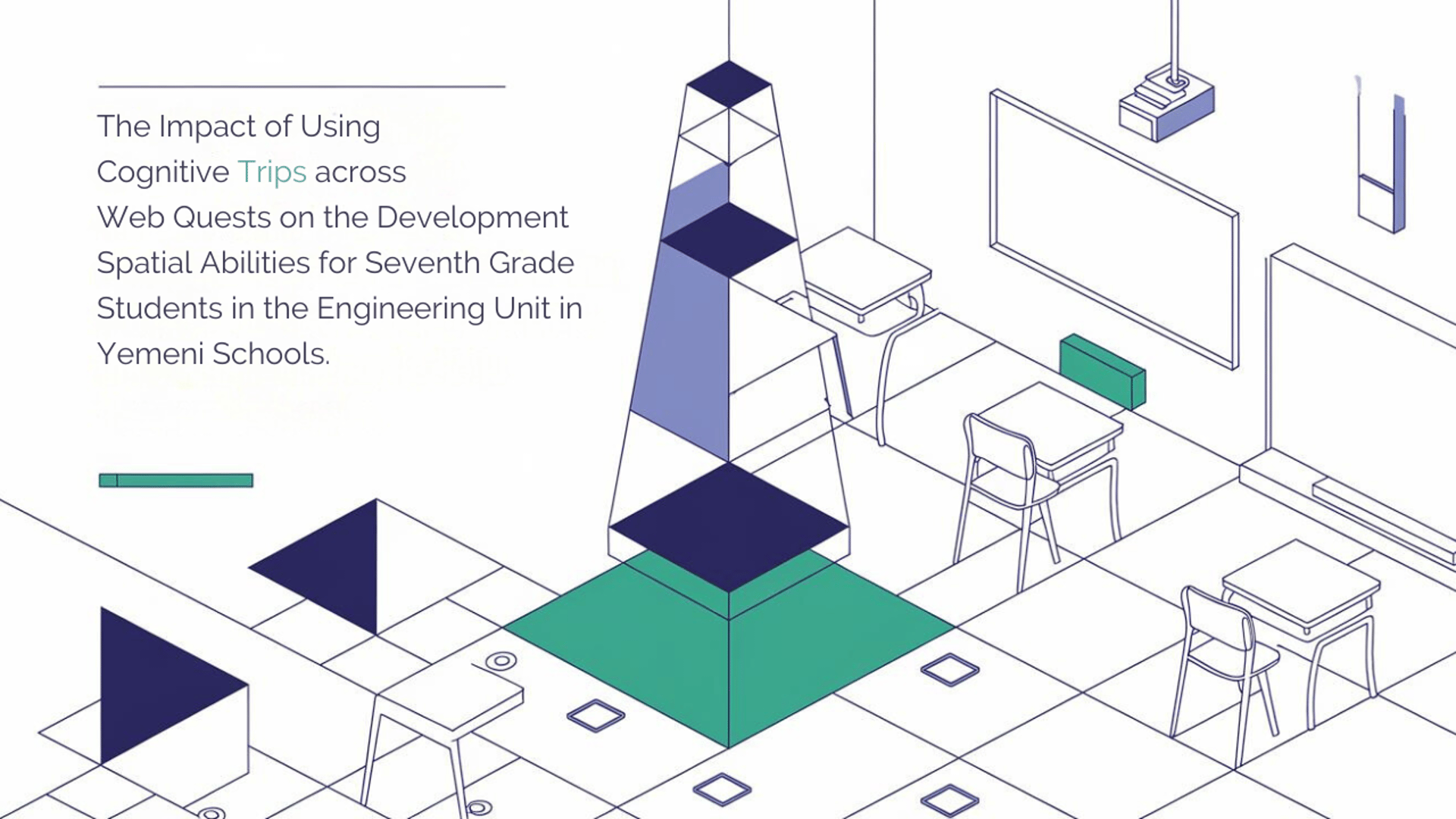
The Impact of Using Cognitive Trips across Web Quest on the Development of Spatial Abilities for Seventh-Grade Students in the Engineering Unit in Yemeni Schools
Bushra Mohammed Qadiri and Abdul-Mahdi Al-Jarah
9/24/202419 min read
Abstract
With advancements in educational technology, innovative methods like WebQuest cognitive journeys have been explored to enhance spatial abilities, critical for success in STEM fields. Spatial skills, particularly in geometry and engineering, are essential for problem-solving and future academic success. This study focuses on improving these abilities in Yemeni secondary school students through WebQuest integration in the mathematics curriculum. The study aims to investigate the impact of employing WebQuest cognitive trips on the development of spatial abilities among seventh-grade students in the Engineering unit in Al-Zahra secondary school in Yemen. A spatial abilities development test was prepared, and computerized software for the sixth unit 'Engineering' for the seventh grade was developed and taught in a WebQuest manner. The study was conducted on a sample of 87 female students, divided into two groups: an experimental group consisting of 45 students and a control group consisting of 42 students. The study revealed several results, the most important of which was the positive effect of using WebQuest cognitive trips in developing the spatial abilities of the study sample. The study recommended restructuring mathematics curriculum units to include activities based on the utilization of the stages of cognitive trips via WebQuest for students to independently access and employ knowledge.
Keywords:
WebQuest, Spatial Abilities, STEM Education, Mathematics Curriculum, Yemeni Secondary School Students
Introduction
Recent years have witnessed remarkable advances in technology and educational methodologies, and this has led to a shift in traditional classroom techniques and the introduction of innovative approaches to teaching and learning. There is an increasing focus on enhancing critical thinking abilities and spatial skills among students, prompting teachers to explore effective methods to improve in these areas. In this regard, incorporating cognitive journeys into Web Quest activities emerges as a promising strategy for enhancing spatial awareness and problem-solving abilities. Mastering spatial thinking is closely linked to success in STEM disciplines because it allows individuals to understand and manipulate spatial relationships, understand engineering concepts, and visualize complex structures and designs. Thus, early nurturing of spatial skills is crucial to developing students’ competencies and preparing them for future academic and professional endeavors. This study aims to explore how cognitive journeys via Web Quest can enhance these abilities, providing empirical evidence to support innovative teaching strategies in the Yemeni educational context.
Understand the findings of the research on cognitive trips via Web Quest in spatial abilities of seventh-grade students in Yemeni schools. Apply the findings in educational practice in Yemen or similar contexts to enhance spatial abilities. This approach amalgamates educational planning, computer utilization, and internet integration to harness students' time, cultivate higher-order thinking capacities, nurture problem-solving skills, and facilitate the exploration of solutions for tasks and challenges spanning various subjects. Particularly, it proves invaluable for subjects' necessitating effort and advanced cognitive abilities, with mathematics occupying a paramount position (AlQubaisy, 2011).
The study indicates the need for further research to delve deeper into the complex dynamics between spatial thinking and computational thinking within TELE environments. Furthermore, there is an urgent need to understand the effects of activity design on skill acquisition and attitudes, along with exploring the optimal timing and duration of TELE interventions to maximize impact. Mathematics, due to its inherent knowledge and skill components that cultivate effective problem-solving approaches, holds a pivotal role (AlOutaiby, 2014). Thus, the conventional teaching strategies for mathematics have become inadequate. They no longer suffice in fostering critical thinking, nurturing creativity, addressing challenges, comprehending mathematical concepts, or scientifically enhancing spatial reasoning. To keep pace with the monumental scientific and technological progress, educational institutions must embrace e-learning models, and among these, the prominent approach is WebQuest cognitive journeys (Abdullrazak, 2014).
The concept of WebQuest, initially introduced by Bernie Dodge in 2001 (Dodge, 2001), constitutes an inquiry-driven educational tool that empowers students to actively and constructively engage with curated resources, both digital and print. The core notion revolves around crafting purposeful and guided activities aimed at delving These activities find resolution through information drawn primarily from pre-selected websites into specific subjects or issues. within the expansive online network, although conventional sources such as books, encyclopedias, magazines, and CDs can also be explored, often involving consultations with individuals knowledgeable about the research topic (Dodge, 2001).
In this context, Salih (2012) underscores the substantial influence of integrating WebQuest cognitive journeys into mathematics instruction. This integration demonstrably enhances students' learning experiences, accelerates accurate calculations, streamlines research across mathematical disciplines, and fosters the refinement of mathematical concepts, spatial acumen, and geometric comprehension.
Similarly, Qatit (2012) highlights that cognitive journeys aim to invigorate student engagement and cultivate both foundational and advanced cognitive competencies. Furthermore, they foster adeptness in wielding contemporary technological tools while furnishing students with tasks that necessitate the application of higher-order thinking skills in knowledge construction and advancement. These journeys empower students to probe specific points with thorough and contemplative exploration, facilitated through meticulously chosen electronic resources. This strategy significantly saves time and effort for both the teacher and the students, protects against distractions, and directs the students’ efforts toward the specific goals of their activities.
Al-Taweel (2012) asserts that cognitive journeys epitomize a teaching strategy wherein students navigate the expanse of the Internet to swiftly access accurate and precise information with minimal exertion. This method transforms the learning experience into an enjoyable endeavor, fostering heightened motivation and cultivating increased classroom engagement among students. Hassan (2013) underscores the indispensability of employing cognitive journeys within the research process. These journeys play a pivotal role in activating students' cognitive faculties, simplifying the application of acquired knowledge, and nurturing robust research capabilities. For these compelling reasons, many educators have embraced cognitive journeys as an integral facet of education. A plethora of Internet resources, meticulously crafted by educators across various academic stages, bolster the availability of such journeys.
Numerous studies have delved into the efficacy of cognitive journeys, particularly in the realm of mathematics education. Allan and Street's investigation underscores the potency of the "cognitive trips" WebQuest approach in engendering positive attitudes toward mathematics (Allan and Street, 2007). Salih's exploration similarly underscores the benefits of employing WebQuests for mathematics learning (Salih, 2012). Abu Khorma's findings accentuate the pivotal role of cognitive journeys in nurturing and enhancing critical thinking skills and mathematical concept acquisition (Abu Khorma, 2013). Al-Omari's research reveals that computerized mathematics curricula significantly contribute to student learning (Al-Omari, 2010). This contribution is manifest in the cultivation of higher-order cognitive abilities, augmentation of students' grasp of mathematical concepts, deepening comprehension of geometric relationships, and rendering arithmetic topics in a visual-spatial manner. The implications of these outcomes are bound to reverberate within students' approaches to solving mathematical challenges.
Obaidat's study (Obaidat, 2012) underscores the significance of addressing students' shortcomings in aspects like estimation, conjecture, and mental imagery These areas, collectively termed the ability to visualize abstract mathematical concepts in spatial imagination, notably influence their mastery of the subject matter and overall achievement. Integrating e-learning methodologies, such as cognitive journeys, into mathematics education holds the potential to enrich the formation of models and geometric relationships. This process simultaneously fosters cognitive growth, ultimately enhancing comprehension of mathematical concepts and proficiency in problem-solving. Notably, spatial ability emerges as a paramount cognitive skill within mathematics curricula and pedagogical approaches, encompassing two principal components: spatial visualization, entailing the transformation of stimuli into mental images, and spatial orientation, involving the capacity to envisage object rotations as complete entities, often requiring timely task completion (Rayan, 2008).
Al-Zghoul and Al-Dababneh (2014) highlight spatial ability's integral role in the cognitive framework, facilitating positive thinking patterns . This attribute contributes to superior work execution with minimal errors, augmented arousal levels, and intrinsic motivation. Moreover, spatial ability emerges as a catalyst for diverse scientific and creative outputs. It serves as a cognitive instrument, a thinking methodology to glean information, formulate problems, and devise solutions. Sen and Neufeld (2006) provide illustrative instances showcasing the applicability of three-dimensional spatial ability in geometry measurement. For instance, one might contemplate the result of pivoting a semicircle along its diameter through a half-turn in space, akin to turning a page in a book. Alternatively, envision the outcome of rotating a rectangle around one of its lengths, completing a full revolution to return it to its initial orientation.
Senan (2003) introduces additional dimensions of spatial abilities embedded within mathematics curricula, encompassing spatial perception. This capacity engages sensorimotor processes to discern spatial interconnections while preserving their inherent structure. Spatial perception emerges from exercises designed to sharpen this faculty, which includes tasks like selecting congruent shapes, identifying distorted forms, and distinguishing non-inverted configurations. Furthermore, other facets such as mental rotation, visualization, and swift, accurate, and effective mental manipulation of shapes in two or three dimensions contribute to spatial orientation. The aptitude to envision objects and spatial relationships, as well as visual-spatial perception involving the cognitive processing of folding surfaces, bolsters the recognition of spatial relationships grounded in similarities and distinctions. This dimension is often quantified through tests involving object assembly or spatial relationship evaluations.
Saleh and Al-Abed (2014) emphasize the indispensable role of honing students' spatial abilities during mathematics education, particularly within the geometry unit[1]. Crafting geometric models and elucidating relationships necessitates unique skills. The mastery of geometry entails not only the application of principles but also proficiency in drawing and adeptness in problem-solving. Hence, nurturing spatial aptitude emerges as a pivotal prerequisite in effectively teaching geometry
Geometry in Yemen is viewed as fundamental to mathematics curricula, and not as an independent subject. Students learn it gradually in mathematics classes to enhance their understanding of engineering principles. This method enables students to connect different mathematics concepts and use geometry in different contexts.
Al-Qadiri (2017) further emphasizes the augmentation of spatial abilities linked to mathematics curricula and pedagogical approaches through the application of cognitive journeys. This augmentation positively influences students' problem-solving acumen and promotes mastery of relationships and geometric configurations. Given the resounding endorsement from educators and specialists, the imperative to evolve mathematics curricula and teaching methodologies centers on nurturing spatial perception, particularly in computational and geometric domains.
The current study addresses the impact of integrating WebQuest cognitive journeys in developing spatial abilities among seventh-grade students, which is considered a stage between the primary and secondary levels, especially within the geometry unit in the mathematics curriculum within the educational context in Yemen.
The study sets out to achieve a tripartite set of objectives. Firstly, it endeavors to elucidate the distinct responsibilities held by both educators and students in the dynamic implementation of educational materials, programmed through the innovative conduit of WebQuest cognitive journeys
Secondly, the study endeavors to discern the tangible impact resultant from the assimilation of WebQuest cognitive journeys within the instructional process. Specifically, it seeks to unravel the multifaceted influence of this approach on the enhancement of spatial abilities among seventh-grade female students in the course of learning the geometry unit of the Yemeni curriculum. The study aims primarily to chart a pioneering path in enhancing mathematics education by addressing the complex spatial relationships presented by engineering topics.Understanding students' perspectives on learning mathematics and geometry is critical to developing successful learning experiences, enabling teachers to address challenges, improve teaching methods, and create a supportive learning environment. Incorporating student feedback improves the quality of mathematics teaching and promotes a deeper understanding and appreciation of the subject among students. Thus, the study investigates the perceptions of the students themselves and draws attention to their opinions regarding both the mathematics curriculum and the new teaching methodology adopted. This third objective demonstrates the holistic approach of the study, seeking not only to evaluate the quantitative effects of the intervention but also to estimate the qualitative dimensions of students' educational experiences. By incorporating this aspect, the study enriches its findings with invaluable insights gained from students' perspectives, enhancing the overall understanding of the effectiveness of the intervention
The geometry unit is the fifth unit in the mathematics textbook for the seventh grade in Yemen and is taught for a month
Methodology
This study employed a quasi-experimental methodology with a pre-post design involving two unevenly sized groups to assess the impact of utilizing WebQuest cognitive trips on the development of mathematical concepts among seventh-grade students in Yemeni schools. This necessitated the creation of two groups: one experimental and the other a control group with the same teacher. The experimental group received instruction using the WebQuest method, while the control group received traditional classroom instruction. Both groups covered unit six (measurement) from the seventh-grade mathematics textbook during the second semester of the 2015/2016 academic year. Data collection occurred in two stages: pre-intervention (before implementing the WebQuest method) and post-intervention (following the WebQuest method). Statistical analysis was conducted to validate the study's hypotheses.
In this research, the traditional method of teaching was lecture-based, where the teacher delivers lectures and explains concepts, theories, and problem-solving methods, and uses textbooks. The students are usually asked to solve a set of problems assigned by the teacher, where the students practice applying the concepts that are taught. In traditional classroom settings characterized by limited student engagement, interactions between students and teachers predominantly occur within the confines of the classroom, with scant avenues for collaborative learning. In such environments, students often prioritize rote memorization and procedural problem-solving techniques, while the teacher assumes a central role in the educational process. Evaluation predominantly relies on tests and problem sets to assess student comprehension and mastery of content.
In contrast, the WebQuest method begins with an introductory overview of the unit topic, providing context and relevance to real-world engineering applications. Students are given access to curated online resources such as interactive simulations, videos, articles, and case studies related to the unit topic. These resources are carefully selected to promote understanding and engagement. Instead of passive learning, students participate in guided inquiry activities designed to enhance critical thinking and problem-solving skills where the student is at the center of the educational process. These activities may include analyzing real-world data, conducting virtual experiments, or participating in online forums for discussion. Also, WebQuests often include elements of cooperative learning in which students work in groups to complete tasks, share results, and provide peer reviews. This plays a role in developing students’ teamwork and communication skills. Assessment and feedback in WebQuests include various formats such as online quizzes, reflective journals, or multimedia presentations. All of these enable students to track their progress and make improvements. Educational technology in general, of which WebQuest is one of its methods, caters to different learning styles and preferences and self-learning in which students have the flexibility to advance at a pace that suits them and to revisit concepts or resources as needed to deepen their understanding. Here the evaluation is continuous with immediate feedback, allowing for continuous improvement.
Study Design
This research uses a quasi-experimental design characterized by a pre-and post-test for unequal groups to evaluate the effect of using WebQuest cognitive journeys in developing spatial abilities among seventh-grade students in Yemen. The study involved two groups of students, an experimental group taught using the WebQuest method, and a control group taught using traditional classroom methods. The two groups studied the sixth unit of the seventh-grade mathematics curriculum (“Measurement”) during the second semester of the 2015-2016 academic year. The study's data collection instruments were administered in two phases: pre-implementation (before using WebQuest) and post-implementation. After that, statistical analyses were performed to test the hypotheses.
The researcher identified activities for each lesson of the sixth unit (Measurement) for the seventh grade, geometry, using the WebQuest method. This material was reviewed by a committee of experts specialized in curriculum, teaching, and educational technology at the Faculty of Educational Sciences at the University of Jordan. Designed using FrontPage and implemented in a computer lab to comply with the WebQuest method.
Spatial Ability Test: The measure of spatial ability used was the Mental Rotation Test, adapted from Al-Abd's (1995) version of the Associate's Science Research Inc.'s Primary Mental Ability (PMA) battery. The scale was adapted and validated in the Arab environment (Al-Abed, 1995), to measure the ability to detect differences between shapes. This 20-item objective test assesses the ability to identify differences between shapes. Each item presents one reference shape along with eight shapes, prompting students to mark “yes” or “no” to indicate whether the shapes on the left match the reference on the right.
To validate the test, two aspects of validity were considered:
1. Content validity: The test was reviewed by an expert committee consisting of 11 bodies specialized in mathematics curricula, teaching methods, educational supervision of mathematics, and mathematics education. Their feedback was considered to improve the wording of the question and remove redundant items. The final test consists of 20 multiple-choice questions, each followed by four alternatives, with one correct answer. Each question was worth one mark, resulting in a total test score of 20 points.
2. Construct validity: The construct validity of the test was evaluated by applying it to a sample of 42 seventh-grade female students who were not members of the study group. The correlation coefficient was calculated between each item and the total score in the spatial abilities test.
Validity
Content validity was assessed through the administration of the test to 42 seventh-grade students beyond the study sample. Item-total correlations ranged from 0.316 to 0.752, affirming the suitability of the items for the study's objectives and indicative of construct validity (Table 1).
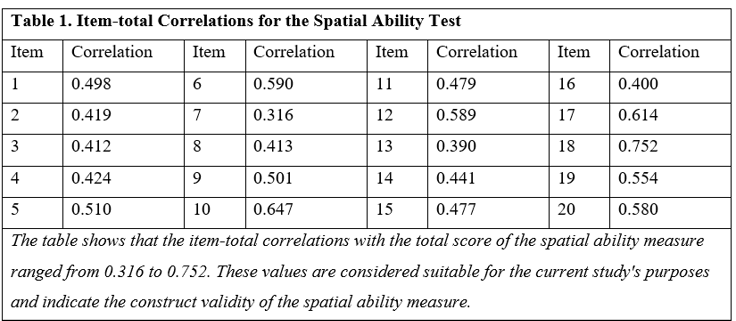

Reliability
Reliability was ascertained using an exploratory sample of 42 seventh-grade students at
Al-Zahra School in Sana'a. The internal consistency computed through the KR-20 formula yielded a reliability coefficient of 0.89. Split-half reliability corrected via the Spearman-Brown prophecy formula was also 0.89 for the spatial ability test.
Variables
The study encompassed the following variables:
Independent variable: Teaching method, consisting of WebQuest cognitive journeys and traditional methods.
Dependent variable: Spatial ability
Design
The study's core objective was to investigate the influence of the experimental independent variable, WebQuest cognitive journeys, on the spatial ability of seventh-grade mathematics students. The design followed a quasi-experimental pre-post non-equivalent groups format, represented as follows:
EG: O1 X O1
CG: O1 – O1
Where:
EG: Experimental group
CG: Control group
X: Treatment (WebQuest instructional material)
O1: Spatial ability pre-post test
To achieve the objectives of the study, the researcher did the following:
1- Obtained an official license from the University of Jordan to conduct research. Research tools formulated and documented based on an initial sample.
2- Cooperated with the mathematics teacher at Al-Zahraa School by providing an outline of the research objective and conducting training courses on the WebQuest application to teach the geometry unit for the seventh grade.
3- The first and second grade students from the seventh grade were randomly distributed into the experimental and control groups, respectively. Administering spatial ability testing for both sectors.
4- WebQuest-oriented instruction was facilitated for the experimental group while the control group received traditional instruction, with both sections taking up the “Engineering” unit over a three-week period.
5- After completing the unit, the researcher administered spatial capacity after examination for both categories. The tests were evaluated, the data was checked in SPSS, the results were clarified, and suggestions were made.
Statistical Analysis
Descriptive statistics, including means and standard deviations, were used to summarize the data. An Analysis of Covariance (ANCOVA) was performed to control for pretest differences between the experimental and control groups, enabling a comparison of post-test scores. The Kuder-Richardson Formula 20 (KR-20) was employed to assess the internal consistency reliability of the test. Additionally, the Spearman-Brown split-half reliability correction was used to further validate test reliability. The effect size was calculated using eta squared (η²) to measure the practical significance of the intervention’s impact
Results
Study Question Outcome
The study addressed the question: "What is the effect of implementing WebQuest cognitive journeys on the enhancement of spatial abilities among seventh-grade students studying the geometry unit in Yemeni schools?" Correspondingly, the null hypothesis postulated: "There are no statistically significant differences (α≤0.05) in the mean scores of spatial ability development among Yemeni seventh-grade students based on the teaching method employed, whether it be WebQuest cognitive journeys or the traditional method.
To investigate the inquiry and evaluate the hypothesis, descriptive statistics including means and standard deviations were computed for the pre-post scores of the experimental and control groups about the spatial ability measure. These outcomes are presented in (Table 2).
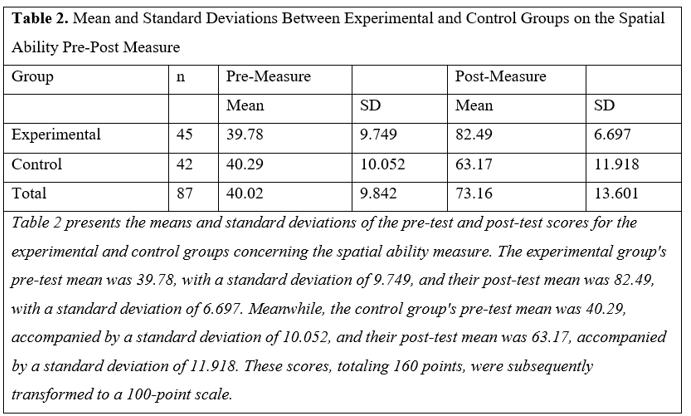

In (Table 3), ANCOVA was executed on post-test scores while controlling for pretest scores to assess the statistical significance of the observed differences in means and standard deviations on the pre-post measures.
Moreover, to identify the sources of differences in the post-test spatial ability scores based on the teaching method, adjusted means and standard deviations were computed, presented in (Table 4).
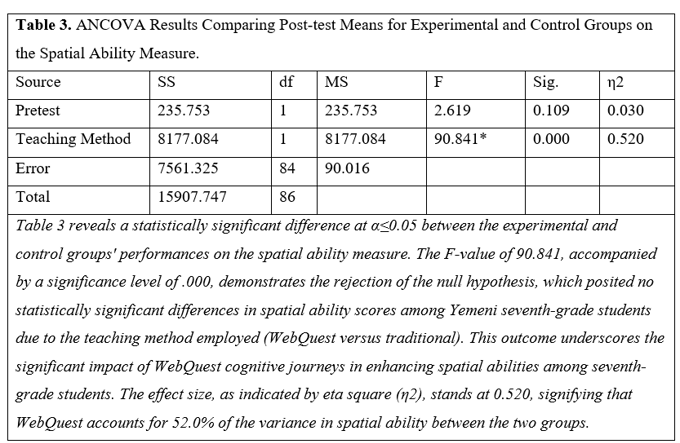

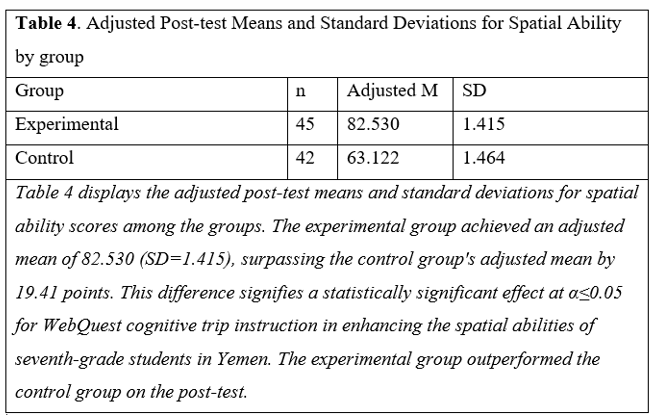

Discussion
The findings of this study reveal a statistically significant difference at α ≤ 0.05 between the experimental and control groups concerning spatial ability development. Specifically, the experimental group, which received instruction via WebQuest cognitive trips, outperformed the control group. This outcome underscores the effectiveness of utilizing WebQuest cognitive trips in enhancing spatial abilities among seventh-grade female students at Al-Zahra School, affiliated with the Thawra District Education Department.
The methodology used in the Web Quest approach promoted deeper reinforcement of spatial skills by providing interactive, captivating, and technologically advanced learning encounters. However, to establish causal relationships and gain a comprehensive understanding of the effectiveness of this intervention, a more comprehensive identification of the specific tasks, teaching techniques, and comparative assessment with the standard curriculum of the control group is necessary. This endeavor would help identify the pivotal elements that led to the remarkable progress and reproduce the methodology in diverse educational settings.
This noticeable improvement in spatial abilities can be attributed to several factors. First, the spatial ability test used in this study involves mentally rotating geometric shapes, engages students in spatial sense activities, and presents images in a three-dimensional format that can be easily understood. This approach facilitates the deeper development of spatial abilities, provides meaningful mathematical experiences, and enhances students' understanding of mathematical concepts, computational tasks, and engineering topics. Thus, students become better equipped to analyze shapes and their interrelationships.
Teachers who use WebQuest methods, after being trained by the researcher, effectively stimulate students' understanding and understanding, while also recognizing students' constructive problem-solving methods. Students' mathematical problem-solving skills improve significantly, leading to higher academic achievement.
WebQuest's inherent nature demands that students engage with images, stimulating their capacity to think critically and creatively. It encourages students to perceive shapes, spaces, colors, lines, and drawings, as well as to translate visual and spatial ideas from memory to construct meaning. WebQuest also fosters students' ability to envision complex mathematical scenarios, introduces fractional and geometric concepts through tangible modeling materials, and promotes observing these concepts from various angles. This holistic approach provides students with a strong foundation for working in three-dimensional spaces. Moreover, it nurtures spatial abilities by involving activities like tracking moving visual scenes and solving mazes manually or visually, all of which are enjoyable activities that contribute to the development of spatial skills. Additionally, students engage in tasks such as reshaping geometric forms, rearranging them, and interpreting their transformations. They also explore the movements of geometric shapes, such as the rotation of a semicircle around its diameter in space or the orbit of a rectangle around one of its sides. These experiences help students perceive and manipulate objects in the third dimension.
Recommendations
Drawing from the study's outcomes and conclusions, the following recommendations are proposed:
Although the traditional method of teaching a geometry module in mathematics has its advantages, the WebQuest method provides a more dynamic and engaging approach that promotes critical and collaborative thinking and real-world application of geometry. Concepts. By leveraging technology and online resources, WebQuests provides students with a richer learning experience tailored to meet the demands of the modern educational landscape.
Incorporation of Online Educational Activities: Mathematics curricula should integrate educational activities that encourage students to explore and investigate information through the global network. This approach aligns with the study's findings, emphasizing the positive impact of online platforms like WebQuest on spatial ability development.
Utilization of WebQuest Cognitive Trips: Mathematics teachers are encouraged to adopt WebQuest cognitive trips as a valuable instructional tool. These trips should be employed to redesign specific units within the mathematics curriculum. This practice has been shown to have a significant influence on enhancing students' spatial abilities.
Professional Development for Educators: Educational supervisors should prioritize the use of WebQuest cognitive trips in mathematics education. To support this, they should provide training courses and professional development opportunities for mathematics teachers, enabling them to effectively integrate WebQuest strategies into their teaching and learning processes.
Acknowledgments
Dr. Bushra Mohammed Rskhan Al-Qadri would like to first and foremost express her gratitude to Allah for facilitating this journey and providing her with the strength and perseverance to pursue her academic and research goals. The authors would like to thank Lynn Paine, Michigan State University, for her valuable review and guidance on the development of this manuscript. Dr. Al-Qadri also acknowledges the generous financial support provided by the AAUW International Fellowship. This fellowship has been instrumental in enabling her to fully engage in her academic program and research without the burden of financial constraints. The funding has empowered her to achieve her educational objectives, and it will ultimately contribute to her professional development and future contributions to the advancement of knowledge in her field.
Conflect of interest
The authors declare that they have no competing interests.
References
1. Abdul Razzaq, Khalil. (2014). The effect of using the quad learning cycle and seven learning cycle strategies in solving mathematical problems and attitudes towards mathematics among tenth-grade students, unpublished PhD dissertation, World Islamic Sciences University, Amman, Jordan.
2. Abu Khorma, Othman. (2013). The effect of teaching using the cognitive trips and Suchman inquiry models in developing critical thinking, motivation and acquiring scientific concepts among eighth-grade female students in mathematics and science courses in schools affiliated with the Jordan Schools Project, unpublished PhD dissertation, Yarmouk University, Irbid, Jordan.
3. Abu Mustafa, Suhaila. (2010). The relationship between spatial ability and achievement in mathematics among sixth-grade students in UNRWA schools, unpublished MA thesis, the Islamic University, Gaza, Palestine.
4. Al-Abed, Adnan. (1995). The development of spatial ability among basic and secondary education students, Yarmouk Research, 11(3), pp. 9-36.
5. Al-Kubaisi, Abdul Wahid. (2011). The effect of using the reciprocal teaching strategy on achievement and mathematical thinking of second intermediate grade students in mathematics, Islamic University Journal (Humanities Series), 19(2) 687 –731.
6. Al-Omari, Akram (2010). Evaluating the effectiveness of the computerized mathematics curriculum in the achievement of tenth-grade students, Journal of Educational and Psychological Sciences, 11(1), pp. 175-203.
7. Al-Otaibi, Bander. (2014). A proposed concept for embedding educational values in the mathematics curriculum for the third grade, unpublished MA thesis, Imam Muhammad Ibn Saud Islamic University, Riyadh, Saudi Arabia.
8. Al-Qadiri, Boshra. (2017). The effect of employing WebQuest cognitive trips on developing mathematical concepts and spatial abilities of seventh-grade students in the geometry unit in Yemeni schools and their attitudes towards it, unpublished PhD dissertation, University of Jordan, Amman, Jordan.
9. Al-Taweel, Marvat. (2012). The effect of WebQuest cognitive trips in teaching social studies on academic achievement and developing technical literacy among secondary education female students, unpublished MA thesis, Umm Al-Qura University, Makkah Al-Mukarramah, Saudi Arabia.
10. Al-Zghoul, Rafe and Al-Dababneh, Khaldoon. (2014). Spatial ability and its relationship to creative thinking and achievement among Al-Hajawi College of Engineering Technology students, Jordanian Journal of Educational Sciences, 10(4) 489-501.
11. Attia, Ibrahim. (2006). The effect of multimedia in teaching geometry on developing geometric problem-solving skills and spatial ability among preparatory stage students, Journal of the Faculty of Education in Zagazig, 2(35), pp. 257-291.
12. El-Baytar, Hamdi. (2005). The effectiveness of a self-education program using the computer to teach the construction accounting course in developing academic achievement, motivation and spatial ability among industrial secondary school students in Asyut school, unpublished PhD dissertation, Assiut University, Egypt.
13. Hassan, Dima (2013). The effect of using WebQuest as a teaching method on English language achievement: A quasi-experimental study of first secondary grade students in official schools in Damascus, unpublished MA thesis, Middle East University, Amman, Jordan.
14. Obeidat, Issam. (2012). Building an educational program based on constructivist theory and testing its impact on developing mathematical thinking skills, academic achievement, and attitudes towards mathematics among primary stage students, unpublished PhD dissertation, World Islamic Sciences University, Amman, Jordan.
15. Qatit, Ghassan. (2012). Teaching computerization, Amman: Dar Al Thaqafa Publishing and Distribution.
16. Ryan, Adel. (2008). Spatial ability among students of Al-Quds Open University majoring in elementary education, Palestinian Journal of Open Education, 1(2), pp. 201-280.
17. Salih, Akram. (2012). Learning mathematics using WebQuest activities for ninth grade "the emotional side", unpublished MA thesis, An-Najah National University, Nablus, Palestine.
18. Saliha, Suhail and Al-Abed, Adnan. (2014). The effect of an educational program supported by light effects in solving mathematical problems and spatial ability among seventh-grade students in Palestine, An-Najah University Journal for Human Sciences, 28(12), pp. 2697-2732.
19. Samara, Nisreen. (2013). The effect of using the WebQuest cognitive trips strategy on direct and delayed achievement of eleventh-grade students in English, unpublished MA thesis, Middle East University, Amman, Jordan.
20. Allan, J., & Street, M. (2007). The quest for deeper learning: investigating the impact of a knowledge pooling WebQuest in primary initial teacher training. British Journal of Educational Technology, 38(6), 1102-1112.
21. Dodge, B. (2001). FOCUS: Five rules for writing a great Web Quest. Retrieved 4/6/2016, from: http://iep.uminho.pt/tce2ecc/pdfs/wqacritical.pdf.
22. Halat, E (2008). The effects of designing web quests on the motivation of pre-service elementary school teachers international. Journal of Mathematical Education in Science and Technology، (39)6, 793- 802.
23. McGlinn, J., & McGlinn, J., (2003). Motivating learning in a humanities class through innovative research assignments: a case study. (ERIC No. ED479392.
24. Sen A., & Neufeld, S (2006). In Pursuit of Alternatives in ELT Methodology: WebQuests Online Submission. Turkish Online Journal of Educational Technology-TOJET, 5(1), 1-20.
25. Senan, E. (2003). Improving the spatial abilities in geometric drawing and Activities" 7\12\2015 Apsce.ne\icee 2003/papers.pdf.
